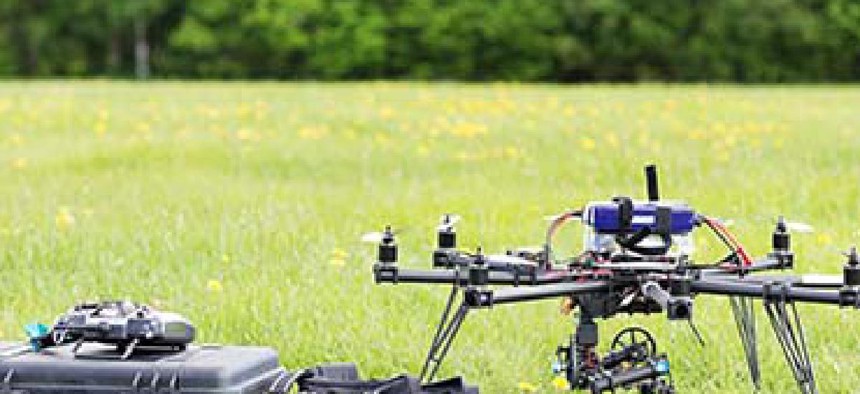Fed agency eyeing commercial UAS apps

The U.S. Geological Survey is watching the FAA-monitored testing of unmanned craft as it ponders possible use of the systems.

At least one federal agency that relies on its own unmanned aerial systems for intricate airborne geo-mapping and other complex tasks is monitoring the development of commercial UAS services in the hope they might save the agency some money and increase operational capacities.
Bruce Quirk, UAS liaison at the U.S. Geological Survey, said the USGS is watching development of commercial aerial monitoring services closely after the Federal Aviation Administration on June 10 issued a certificate of waiver or authorization for BP to fly a hand-launched unmanned aerial vehicle in Alaska. The overland operational permit for the four-foot long AeroVironment Puma AE with a nine-foot wingspan was the first allowed by the FAA, opening the door a bit further to commercial operation of unmanned systems over the entire U.S.
BP, however, didn’t buy the complete unmanned system for the Alaska duties, but contracted for high-resolution aerial survey services from AeroVironment in a kind of drone-as-as-service arrangement with the company. Those services, said Steve Gitlin, vice president at AeroVironment, include extremely sensitive measurements and detailed data of roads and other infrastructure in BP’s environmentally sensitive Prudhoe Bay oil field.
That sort of detailed surveying is right up USGS’s alley.
“When the FAA finally opens up the national airspace system for commercial operations, the USGS will investigate service contracts with the commercial sector that would provide the data sets we need to meet our mission,“ Quirk said in an email to FCW. “We already have a contract vehicle in place called the Geospatial Product and Service Contracts that we could use to secure these services.“
For now, the agency is waiting on the FAA to make a bit more progress in opening commercial air space.
“We’ll depend on the FAA to tell us when it’s ‘open.’ It might happen in stages,“ Quirk said. “For example, they might open up commercial operations in G airspace first.“ G Class airspace includes all airspace below flight level 600 not otherwise classified as controlled. It’s one of seven airspace classifications in the U.S.
“It will also depend on how and when the FAA certifies commercial operators,” he said. “I think that the FAA will require the commercial vendors to have both certified aircraft and pilots. The Australians have a list of certified UAS operators and I don’t know if the FAA will do something similar or how they will do the certification.“
BP’s Puma was equipped to supply extremely detailed mapping, equipped with either custom integrated LiDAR (Light Detection and Ranging) or standard electro-optical and infrared sensor payload. The sensor payloads produce imagery and data for processing into 3D computerized models of roads, pads and pipelines, and other actionable information, including precision volumetric measurement and topographic analysis of gravel pits at Prudhoe Bay’s North Slope field.
The imaging, said Gitlin, was backed by data processing systems to crunch the data the aerial vehicle generated. One of system’s jobs was monitoring the condition of 20 miles of road in support of BP’s massive three-and-a-half-million pound mobile drilling rig. The heavy equipment requires extremely smooth roads to avoid damage when it moves from site to site. The UAS, said Gitlin, for instance could measure up to the centimeter how much gravel might be needed to fill each pothole along the vehicle’s route.
Federal agencies have been turning to unmanned aircraft for a growing variety of jobs, including detailed geological surveying, to disaster recovery and forest monitoring. Traditionally, they’ve used repurposed, older vehicles obtained from the Department of Defense that had seen duty in Iraq and Afghanistan. The systems require maintenance and sometimes upgrades, to fit exactly into an agency’s envelope of applications. They can also lack some of the more sophisticated capabilities that newer systems incorporate.
Emerging, next-generation UAS services could offer less-expensive, more mission-specific options down the road to agencies that don’t want to buy their own systems, according to Gitlin. CBP, for instance, has a fleet of large Predator-class aerial vehicles to perform high level monitoring of U.S. borders. However, a small aerial vehicle and monitoring system like the Puma could offer individual border agents a localized tool to watch specific areas.
In 2012, Congress told the FAA to develop a plan to safely integrate drones into civil airspace by September 2015. The FAA has been issuing limited permits and is working to propose regulations this year for smaller unmanned vehicles that weigh less than 55 pounds.





